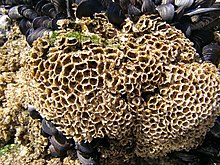Funnel worm
| Funnel worm | ||||||||||||
|---|---|---|---|---|---|---|---|---|---|---|---|---|

Funnel worm ( Sabellaria alveolata ) |
||||||||||||
| Systematics | ||||||||||||
|
||||||||||||
| Scientific name | ||||||||||||
| Sabellaria alveolata | ||||||||||||
| ( Linnaeus , 1767) |
The funnel worm that bees cell or Southern sand coral ( Sabellaria Alveolata ) is a sessile, röhrenbauender , reef-building , as filter feeders living polychaete (Polychaeta) from the family of sandy coral (Sabellariidae), which in the northern Atlantic Ocean can be found.
features
Sabellaria alveolata has a thin, cylindrical and smooth, wine-red to brownish, spotted body with 37 bristle-bearing segments and a brown-colored tail section, which tapers gradually towards the rear end, up to about 4 cm long . The rearmost section, referred to as the post-abdomen, lies folded forward in an abdominal groove of the abdomen, with the anus pointing forward. At sexual maturity, the females turn purple and the males whitish.
The outer bristles of the operculum are covered with 4 to 5 teeth, the middle of which is smooth and hardly longer than the lateral ones. The middle bristles of the operculum are kneeled, hollowed out subdistally and tapering distally. The inner bristles of the operculums are similar to the central ones, but longer. Ventrally on the mouth there are numerous thread-like tentacle filaments, and between the tentacle tips there are two short, conical palps ventrally .
The first bristle-bearing segment has oval neuropodia on which there are toothed capillary-like bristles. On the second bristle-bearing segment there are toothed capillary-like bristles and a small triangular cirrus on the neuropodia . From the second bost-bearing segment on, each segment has gills , the length of which decreases towards the rear.
The last 3 segments of the thorax have rectangular notopodia , each with 8 to 10 large paddle-shaped bristles. The neuropodia do not carry cirrus, and their bristles are similar to those on the notopodia, but smaller. The abdomen is characterized by notopodia with lateral, fleshy flaps on which short hooks with about 5 to 6 teeth each sit, while the papilla-like neuropodia there are covered with long, feather-like capillary-like bristles.
Sabellaria alveolata is very similar to the closely related Sabellaria spinulosa and is therefore difficult to tell apart. It differs from this mainly in the shape of the bristles in the outer and middle rows on the operculum. In addition, the reefs formed by their living tubes can become much more powerful.
Residential tube
The living tubes of Sabellaria alveolata consist of grains of sand that are collected with the paleae at the mouth and cemented with the solidified mucus (cement substance) deposited by cement glands on the 2nd segment. Often the animals appear in large numbers next to each other with their living tubes, so that the openings of the tubes result in a honeycomb-like pattern.
Development cycle
Sabellaria alveolata is separate sexes and is around 3 to 5 years old, exceptionally up to 9 years old. In July, the females turn purple and the males whitish and release their gametes so that fertilization takes place in open sea water. In around 12 hours, the zygotes develop into free-swimming trochophora larvae, which, depending on the environmental conditions, live as zooplankton for 6 weeks to 6 months , which feed on phytoplankton . The mature larva is finally recognizable as a sabellariid by its bristles (paleae) on the mouth and sinks to the ground in order to metamorphose into a creeping worm and to build a living tube. The reefs of Sabellaria alveolata go through regular cycles of growth and decay within a few years, but undisturbed sites usually remain as such for a long time.
nutrition
Sabellaria Alveolata feeds as filter feeders of detritus .
Distribution, habitat and endangerment
Sabellaria alveolata is widespread in the northern Atlantic Ocean as far as Senegal and was earlier also in the North Sea . The polychaet lives in the intertidal zone down to a depth of 26 m, where it builds cylindrical living tubes from slime and grains of sand, which can often form large reefs. In the 19th century there were more than 20 large sand coral reefs in the Wadden Sea of the German Empire , but the species is now extinct in these areas, and within the North Sea there are only residual occurrences off the British Isles . The reason for the disappearance of the sand corals is trawling , whose bottom trawls have destroyed all reefs in the regions mentioned.
literature
- Gesa Hartmann-Schröder (1996): Annelida, Borstenwürmer, Polychaeta. Tierwelt Deutschlands 58, pp. 1–648, here p. 497, Sabellaria alveolata .
- John D. Fish, Susan Fish: A Student's Guide to the Seashore . Cambridge University Press, Cambridge 2011. 540 pages. Sabellaria alveolata (Linnaeus) , pp. 168f.
- Stanley J. Edmonds: Fauna of Australia, Volume 4A. Polychaetes & Allies. The Southern Synthesis 4. Commonwealth of Australia, 2000. Class Polychaeta. Pp. 239-243, Family Sabellariidae.
- UK Biodiversity Group Tranche 2 Action Plans. October 1999, Tranche 2, Volume V, p. 125.
Web links
- Species profile of the southern sand coral at Beach Explorer
- MJ de Kluijver et al .: Sabellaria alveolata (Linnaeus, 1767). Macrobenthos of the North Sea - Polychaeta, Marine Species Identification Portal
- A. Jackson: Sabellaria alveolata (Linnaeus, 1767). In: H. Tyler-Walters, K. Hiscock (Eds.): Marine Life Information Network, Biology and Sensitivity Key Information Reviews. Marine Biological Association of the United Kingdom, Plymouth 2008.
- Sand coral profile. Nature Conservation Association Germany.
- Sabellaria alveolata. UK Marine Special Areas of Conservation.
